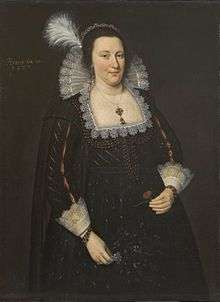Adam de Colone

Adam de Colone, or Adam Louisz. de Colonia (c. 1572 in Antwerp – buried 19 August 1651 in Rotterdam), was a Dutch Golden Age painter active in Scotland during the reigns of James VI and I and Charles I of England.
Biography

It has been assumed that Adrian was the son of the King's Painter in Scotland, Adriaen van Sonne (Vanson) and his wife Susanna de Colonia. However, more recent research reveals, according to the Netherlands Institute for Art History, that Adam was the brother of Susanna de Colonia, and they were the children of an Antwerp saddle maker Louis Jansz Colonia. Adam painted under the name Adam de Colonia in Rotterdam in the 1630s.[1][2][3] Accordingly, Adrian Vanson, court painter to James VI, was Adam's brother-in-law. Adrian was originally from the Netherlands though all his children were born in Edinburgh.[4] [5] Adam is presumed to have studied in the Low Countries, in 1598 he joined the guild in Dordrecht, and was presumably already active as a painter in 1593 in Rotterdam when he married. He was father of the painter Isaac Colonia (1611-1663) and grandfather of Adam Colonia (1634-1685).[1] He moved to London in 1622 and settled in Scotland in 1624. Working at the Court in Whitehall he painted at least two full-length portraits of James VI in 1623, and many of the Scottish nobility.[6] He was paid for London portraits by James I in 1623.[4] (It is unclear if Adam joined his sister in Edinburgh before 1620.)
The earliest portrait of a Scottish sitter recognized as Adam's work is dated 1622, though his portrait of Sir William Stewart of Grandtully (1567-1646) is dated 1613. Most of his works have painted inscriptions showing distinctively shaped letters and numerals. A record of payments in 1628 by George Seton, 3rd Earl of Winton for portraits is preserved;
Item gevine to Adame the painter for my Lord Errol, my Lady Hay, and James Maxwells portraits, 86 lib. 13b s. 4 d.
Item, gevine to Adame the painter for my aune portraitte gevine to my sister (Isobel Seton), 40 lib.[7]
The influence of the Netherlandish style on Scottish portraits is apparent from 1478 when Hugo van der Goes’s Trinity Altarpiece arrived in Scotland. It depicted James III of Scotland, Margaret of Denmark, Queen of Scotland, Prince James and a praying cleric, thought to be the contemporary Provost of Trinity College Kirk, Edward Bonkil, accompanied by two angels playing an organ. Painted in Ghent, it was displayed in the Chapel of the Holy Trinity in Edinburgh.
The two court painters of James VI were Arnold Bronckorst and Adrian Vanson, both from the Netherlands.[8]
The Copenhagen Museum displays a picture by him of 'Noah building the Ark'; and the Lille Museum has 'The Angel appearing to the Shepherds' attributed to him.
| Wikimedia Commons has media related to Adam de Colone. |
References
- 1 2 Adam Louisz. de Colognia in the RKD
- ↑ Art History News
- ↑ http://www.codart.nl/news/762/
- 1 2 Adam de Colone in the RKD
- ↑ National Portrait Gallery
- ↑ National Galleries Scotland
- ↑ J. Stuart, ed., HMC, 2nd Report, 'Papers of Forbes Leith of Whitehaugh' (1874), p. 199: D. Thomson, Painting in Scotland, 1570-1650, (Edinburgh 1975), 52, notes the pictures may been painted in London.
- ↑ Philip Mould
